OC, HPC, UHPC and UHPFRC Corrosion Performance in the Marine Environment
Abstract
:1. Introduction
2. Experimental Plan
2.1. Materials
2.2. Test Methods
2.2.1. Porosity Accessible to Water
2.2.2. Capillary Absorption Coefficient
2.2.3. Oxygen Permeability Coefficient
2.2.4. Chloride Migration Coefficient
2.2.5. Chloride Diffusion Coefficient
2.2.6. Concrete Resistivity
2.2.7. Corrosion Rate
3. Results
3.1. Porosity Accessible to Water
3.2. Capillary Absorption Coefficient
3.3. Oxygen Permeability Coefficient
3.4. Chloride Migration Coefficient
3.5. Chloride Diffusion Coefficient
3.6. Concrete Resistivity
3.7. Corrosion Rate
3.8. Summary of the Results
4. Conclusions
- In the HPC and UHPCs, water absorption and capillary absorption were between six- and eight-fold lower than in OCs. In addition, the oxygen permeability coefficient was two and three orders of magnitude lower in HPC and in UHPCs, respectively;
- The non-steady state migration coefficient () and the apparent diffusion coefficient () were one order of magnitude lower than for OCs. The values obtained for concretes C150-F and C150-NF were almost two orders of magnitude lower, but due to the steel fibres, the resistance to chloride penetration was somewhat lower in C150-F than in C150-NF. In any case, the values obtained in both concretes were well below the threshold for very high durability (1 × 10−12 m2/s);
- Resistivity analysis evidenced differences among concretes. Ordinary concretes (C30, C40 and C50) showed values close to 100 Ωm. Conversely C90 and C150-F reached values that were almost one order of magnitude higher. In addition, a large difference between concretes C150-NF and C150-F was found. With UHPC, to which no steel fibres were added, values exceeded 5500 Ωm, which were five-fold those obtained with the same concrete, but to which steel fibres had been added. These data indicate steel fibres increase material’s conductivity and significantly reduce concrete’s resistivity. In any case, however, steel fibres do not prevent the reference values denoting very high durability from being obtained;
- The corrosion rates of the rebars embedded in OCs after being exposed to a marine environment for more than 3 years were high (>10 µm/year). In HPC, UHPC and UHPFRC, corrosion was negligible (<1 µm/year). Regarding accumulated damage, the mass loss estimated at the end of the study in the rebars embedded in C90, C150-NF and C150-F was, respectively, 9.5, 6.2 and 3.5 mg. On the contrary, the values obtained with OCs were two orders of magnitude higher: 328.9, 267.9 and 170.4 mg in C30, C40 and C50, respectively.
Author Contributions
Funding
Data Availability Statement
Acknowledgments
Conflicts of Interest
References
- Gagg, C.R. Cement and concrete as an engineering material: An historic appraisal and case study analysis. Eng. Fail. Anal. 2014, 40, 114–140. [Google Scholar] [CrossRef]
- Angst, U.M. Challenges and opportunities in corrosion of steel in concrete. Mater. Struct. Constr. 2018, 51, 4. [Google Scholar] [CrossRef]
- Flatt, R.J.; Roussel, N.; Cheeseman, C.R. Concrete: An eco material that needs to be improved. J. Eur. Ceram. Soc. 2012, 32, 2787–2798. [Google Scholar] [CrossRef]
- Ajwad, A.; Ilyas, U.; Rashid, M.U.; Shafiq, M.I. Assessing Strengthening Techniques of Bonding overlay Concrete to Existing Concrete Elements. NFC IEFR J. Eng. Sci. Res. 2017, 5, 15–18. [Google Scholar] [CrossRef]
- Ramírez, G.P.M.; Byliński, H.; Niedostatkiewicz, M. Deterioration and protection of concrete elements embedded in contaminated soil: A review. Materials 2021, 14, 3253. [Google Scholar] [CrossRef]
- Safiuddin, M. Concrete damage in field conditions and protective sealer and coating systems. Coatings 2017, 7, 90. [Google Scholar] [CrossRef]
- Sohail, M.G.; Wang, B.; Jain, A.; Kahraman, R.; Ozerkan, N.G.; Gencturk, B.; Dawood, M.; Belarbi, A. Advancements in Concrete Mix Designs: High-Performance and Ultrahigh-Performance Concretes from 1970 to 2016. J. Mater. Civ. Eng. 2018, 30, 04017310. [Google Scholar] [CrossRef]
- Demis, S.; Papadakis, V.G. Durability design process of reinforced concrete structures—Service life estimation, problems and perspectives. J. Build. Eng. 2019, 26, 100876. [Google Scholar] [CrossRef]
- Alexander, M.; Beushausen, H. Durability, service life prediction, and modelling for reinforced concrete structures—Review and critique. Cem. Concr. Res. 2019, 122, 17–29. [Google Scholar] [CrossRef]
- Basheer, L.; Kropp, J.; Cleland, D.J. Assessment of the durability of concrete from its permeation properties: A review. Constr. Build. Mater. 2001, 15, 93–103. [Google Scholar] [CrossRef]
- De Medeiros-Junior, R.A.; de Lima, M.G.; de Medeiros, M.H.F. Service life of concrete structures considering the effects of temperature and relative humidity on chloride transport. Environ. Dev. Sustain. 2015, 17, 1103–1119. [Google Scholar] [CrossRef]
- Shi, X.; Xie, N.; Fortune, K.; Gong, J. Durability of steel reinforced concrete in chloride environments: An overview. Constr. Build. Mater. 2012, 30, 125–138. [Google Scholar] [CrossRef]
- Val, D.V.; Stewart, M.G. Life-cycle cost analysis of reinforced concrete structures in marine environments. Struct. Saf. 2003, 25, 343–362. [Google Scholar] [CrossRef]
- Angst, U.; Elsener, B.; Larsen, C.K.; Vennesland, Ø. Critical chloride content in reinforced concrete—A review. Cem. Concr. Res. 2009, 39, 1122–1138. [Google Scholar] [CrossRef]
- Rodrigues, R.; Gaboreau, S.; Gance, J.; Ignatiadis, I.; Betelu, S. Reinforced concrete structures: A review of corrosion mechanisms and advances in electrical methods for corrosion monitoring. Constr. Build. Mater. 2021, 269, 121240. [Google Scholar] [CrossRef]
- Tuutti, K. Corrosion of Steel in Concrete; Swedish Cement and Concrete Research Instittute: Stockholm, Sweden, 1982. [Google Scholar]
- Moser, R.D.; Singh, P.M.; Kahn, L.F.; Kurtis, K.E. Chloride-induced corrosion resistance of high-strength stainless steels in simulated alkaline and carbonated concrete pore solutions. Corros. Sci. 2012, 57, 241–253. [Google Scholar] [CrossRef]
- Gu, P.; Elliott, S.; Beaudoin, J.J.; Arsenault, B. Corrosion resistance of stainless steel in chloride contaminated concrete. Cem. Concr. Res. 1996, 26, 1151–1156. [Google Scholar] [CrossRef]
- Rabi, M.; Shamass, R.; Cashell, K.A. Structural performance of stainless steel reinforced concrete members: A review. Constr. Build. Mater. 2022, 325, 126673. [Google Scholar] [CrossRef]
- Cramer, S.D.; Covino, B.S.; Bullard, S.J.; Holcomb, G.R.; Russell, J.H.; Nelson, F.J.; Laylor, H.M.; Soltesz, S.M. Corrosion prevention and remediation strategies for reinforced concrete coastal bridges. Cem. Concr. Compos. 2002, 24, 101–117. [Google Scholar] [CrossRef]
- Yang, D.Y.; Frangopol, D.M.; Teng, J.G. Probabilistic life-cycle optimization of durability-enhancing maintenance actions: Application to FRP strengthening planning. Eng. Struct. 2019, 188, 340–349. [Google Scholar] [CrossRef]
- Calvet, V.; Valcuende, M.; Benlloch, J.; Cánoves, J. Influence of moderate temperatures on the bond between carbon fibre reinforced polymer bars (CFRP) and concrete. Constr. Build. Mater. 2015, 94, 589–604. [Google Scholar] [CrossRef]
- López, F.C.-G.; Marco, J.B.; Rodríguez, V.C. Influence of high temperatures on the bond between carbon Fibre-Reinforced polymer bars and concrete. Constr. Build. Mater. 2021, 309, 124967. [Google Scholar] [CrossRef]
- Benmokrane, B.; Wang, P.; Ton-That, T.M.; Rahman, H.; Robert, J.-F. Durability of Glass Fiber-Reinforced Polymer Reinforcing Bars in Concrete Environment. J. Compos. Constr. 2002, 6, 143–153. [Google Scholar] [CrossRef]
- Hao, Q.; Wang, Y.; He, Z.; Ou, J. Bond strength of glass fiber reinforced polymer ribbed rebars in normal strength concrete. Constr. Build. Mater. 2009, 23, 865–871. [Google Scholar] [CrossRef]
- Yi, Y.; Zhu, D.; Guo, S.; Zhang, Z.; Shi, C. A review on the deterioration and approaches to enhance the durability of concrete in the marine environment. Cem. Concr. Compos. 2020, 113, 103695. [Google Scholar] [CrossRef]
- ACI 363 Report on High-Strength Concrete. 2015. Available online: https://www.academia.edu/8275753/ACI_363r_92_State_of_the_Art_Report_on_High_Strength_Concrete (accessed on 16 July 2023).
- Faleschini, F.; Fernández-Ruíz, M.A.; Zanini, M.A.; Brunelli, K.; Pellegrino, C.; Hernández-Montes, E. High performance concrete with electric arc furnace slag as aggregate: Mechanical and durability properties. Constr. Build. Mater. 2015, 101, 113–121. [Google Scholar] [CrossRef]
- Aïtcin, P.C. The durability characteristics of high performance concrete: A review. Cem. Concr. Compos. 2003, 25, 409–420. [Google Scholar] [CrossRef]
- Wu, K.R.; Chen, B.; Yao, W.; Zhang, D. Effect of coarse aggregate type on mechanical properties of high-performance concrete. Cem. Concr. Res. 2001, 31, 1421–1425. [Google Scholar] [CrossRef]
- Beushausen, H.; Dittmer, T. The influence of aggregate type on the strength and elastic modulus of high strength concrete. Constr. Build. Mater. 2015, 74, 132–139. [Google Scholar] [CrossRef]
- Kiliç, A.; Atiş, C.D.; Teymen, A.; Karahan, O.; Özcan, F.; Bilim, C.; Özdemir, M. The influence of aggregate type on the strength and abrasion resistance of high strength concrete. Cem. Concr. Compos. 2008, 30, 290–296. [Google Scholar] [CrossRef]
- Beshr, H.; Almusallam, A.A.; Maslehuddin, M. Effect of coarse aggregate quality on the mechanical properties of high strength concrete. Constr. Build. Mater. 2003, 17, 97–103. [Google Scholar] [CrossRef]
- Zhou, F.P.; Lydon, F.D.; Barr, B.I.G. Effect of coarse aggregate on elastic modulus and compressive strength of high performance concrete. Cem. Concr. Res. 1995, 25, 177–186. [Google Scholar] [CrossRef]
- Bharatkumar, B.H.; Narayanan, R.; Raghuprasad, B.K.; Ramachandramurthy, D.S. Mix proportioning of high performance concrete. Cem. Concr. Compos. 2001, 23, 71–80. [Google Scholar] [CrossRef]
- Poon, C.S.; Lam, L.; Wong, Y.L. Study on high strength concrete prepared with large volumes of low calcium fly ash. Cem. Concr. Res. 2000, 30, 447–455. [Google Scholar] [CrossRef]
- Baroghel-Bouny, V. Conception des Bétons pour une Durée de vie Donnée des Ouvrages—Maîtrise de la Durabilité vis-à-vis de la Corrosion des Armatures et de L’alcali-Réaction—Etat de l’art et Guide pour la Mise en Oeuvre d’une Approche Performantielle et Prédictive sur la bas, Bagneux, France. 2004. Available online: https://eprints.uanl.mx/5481/1/1020149995.PDF (accessed on 24 July 2023).
- Khan, M.I.; Lynsdale, C.J. Strength, permeability, and carbonation of high-performance concrete. Cem. Concr. Res. 2002, 32, 123–131. [Google Scholar] [CrossRef]
- Shi, H.S.; Xu, B.W.; Shi, T.; Zhou, X.C. Determination of gas permeability of high performance concrete containing fly ash. Mater. Struct. Constr. 2008, 41, 1051–1056. [Google Scholar] [CrossRef]
- Sheng, S.H.; Xu, W.B.; Zhou, X.C. Influence of mineral admixtures on compressive strength, gas permeability and carbonation of high performance concrete. Constr. Build. Mater. 2009, 23, 1980–1985. [Google Scholar] [CrossRef]
- Zhang, X.; Zhou, X.; Zhou, H.; Gao, K.; Wang, Z. Studies on forecasting of carbonation depth of slag high performance concrete considering gas permeability. Appl. Clay Sci. 2013, 79, 36–40. [Google Scholar] [CrossRef]
- Ozawa, M.; Sakoi, Y.; Fujimoto, K.; Tetsura, K.; Parajuli, S.S. Estimation of chloride diffusion coefficients of high-strength concrete with synthetic fibres after fire exposure. Constr. Build. Mater. 2017, 143, 322–329. [Google Scholar] [CrossRef]
- Song, H.W.; Kwon, S.J. Evaluation of chloride penetration in high performance concrete using neural network algorithm and micro pore structure. Cem. Concr. Res. 2009, 39, 814–824. [Google Scholar] [CrossRef]
- ASTM C1202; Standard Test Method for Electrical Indication of Concrete’s Ability to Resist Chloride Ion Penetration. ASTM: West Conshohocken, PA, USA, 2012. [CrossRef]
- NORDTEST. NT Build 492. Rapid Chloride Migration Test (RCMT), Nord. Method. Nord. Coop. 1999, pp. 1–8. Available online: https://salmanco.com/wp-content/uploads/2018/10/NT-Build-492.pdf (accessed on 22 August 2023).
- Shi, C.; Jiao, D.; Zhang, J.; Wang, D.; Zhang, Y.; Farzadnia, N.; Hu, X. Design of high performance concrete with multiple performance requirements for #2 Dongting Lake Bridge. Constr. Build. Mater. 2018, 165, 825–832. [Google Scholar] [CrossRef]
- Kubissa, W.; Simon, T.; Jaskulski, R.; Reiterman, P.; Supera, M. Ecological High Performance Concrete. Procedia Eng. 2017, 172, 595–603. [Google Scholar] [CrossRef]
- Kim, H.K.; Jang, J.G.; Choi, Y.C.; Lee, H.K. Improved chloride resistance of high-strength concrete amended with coal bottom ash for internal curing. Comput. Chem. Eng. 2014, 71, 334–343. [Google Scholar] [CrossRef]
- Gonzalez-Corominas, A.; Etxeberria, M.; Poon, C.S. Influence of steam curing on the pore structures and mechanical properties of fly-ash high performance concrete prepared with recycled aggregates. Cem. Concr. Compos. 2016, 71, 77–84. [Google Scholar] [CrossRef]
- Akca, A.H.; Zihnio, N.Ö. High performance concrete under elevated temperatures. Constr. Build. Mater. 2013, 44, 317–328. [Google Scholar] [CrossRef]
- Noumowe, A.N.; Siddique, R.; Debicki, G. Permeability of high-performance concrete subjected to elevated temperature (600 °C). Constr. Build. Mater. 2009, 23, 1855–1861. [Google Scholar] [CrossRef]
- Chan, Y.N.; Peng, G.F.; Anson, M. Residual strength and pore structure of high-strength concrete and normal strength concrete after exposure to high temperatures. Cem. Concr. Compos. 1999, 21, 23–27. [Google Scholar] [CrossRef]
- Chan, Y.N.; Luo, X.; Sun, W. Compressive strength and pore structure of highperformance concrete (chan). Cem. Concr. Res. 2000, 30, 247–251. [Google Scholar] [CrossRef]
- Gonzalez-Corominas, A.; Etxeberria, M. Effects of using recycled concrete aggregates on the shrinkage of high performance concrete. Constr. Build. Mater. 2016, 115, 32–41. [Google Scholar] [CrossRef]
- Tayeh, B.A.; Saffar, D.M.A.; Alyousef, R. The Utilization of Recycled Aggregate in High Performance Concrete: A Review. J. Mater. Res. Technol. 2020, 9, 8469–8481. [Google Scholar] [CrossRef]
- Huang, H.; Gao, X.; Wang, H.; Ye, H. Influence of rice husk ash on strength and permeability of ultra-high performance concrete. Constr. Build. Mater. 2017, 149, 621–628. [Google Scholar] [CrossRef]
- Zhang, M.H.; Malhotra, V.M. High-performance concrete incorporating rice husk ash as a supplementary cementing material. ACI Mater. J. 1996, 93, 629–636. [Google Scholar] [CrossRef]
- Cordeiro, G.C.; Filho, R.D.T.; De Moraes, R.F.E. Use of ultrafine rice husk ash with high-carbon content as pozzolan in high performance concrete. Mater. Struct. Constr. 2009, 42, 983–992. [Google Scholar] [CrossRef]
- AlKhatib, A.; Maslehuddin, M.; Al-Dulaijan, S.U. Development of high performance concrete using industrial waste materials and nano-silica. J. Mater. Res. Technol. 2020, 9, 6696–6711. [Google Scholar] [CrossRef]
- Suzuki, M.; Meddah, M.S.; Sato, R. Use of porous ceramic waste aggregates for internal curing of high-performance concrete. Cem. Concr. Res. 2009, 39, 373–381. [Google Scholar] [CrossRef]
- Larrard, F.; Sedran, T. Optimization of ultra-high-performance concrete by the use of a packing model. Cem. Concr. Res. 1994, 24, 997–1009. [Google Scholar] [CrossRef]
- Camacho Torregrosa, E. Dosage Optimization and Bolted Connections for UHPFRC Ties. Dosage Optimization and Bolted Connections for UHPFRC. Ph.D. Thesis, Universitat Politècnica de València, Valencia, Spain, 2013. Available online: https://riunet.upv.es/handle/10251/34790?show=full (accessed on 11 July 2023).
- AFGC/SETRA Groupe de Travail BFUP. Bétons Fibrés à Ultra-Hautes Performances; ACI: Farmington Hills, MI, USA, 2002. [Google Scholar] [CrossRef]
- Resplendino, J. Ultra High Performance Concrete: New AFGC Recommendations. Des. Build. UHPFRC 2013, 10, 713–722. [Google Scholar] [CrossRef]
- Azmee, N.M.; Shafiq, N. Ultra-high performance concrete: From fundamental to applications. Case Stud. Constr. Mater. 2018, 9, e00197. [Google Scholar] [CrossRef]
- Kansal, C.M.; Goyal, R. Effect of nano silica, silica fume and steel slag on concrete properties. Mater. Today Proc. 2021, 45, 4535–4540. [Google Scholar] [CrossRef]
- Xi, J.; Liu, J.; Yang, K.; Zhang, S.; Han, F.; Sha, J.; Zheng, X. Role of silica fume on hydration and strength development of ultra-high performance concrete. Constr. Build. Mater. 2022, 338, 127600. [Google Scholar] [CrossRef]
- Xiong, X.; Wu, M.; Shen, W.; Li, J.; Zhao, D.; Li, P.; Wu, J. Performance and microstructure of ultra-high-performance concrete (UHPC) with silica fume replaced by inert mineral powders. Constr. Build. Mater. 2022, 327, 126996. [Google Scholar] [CrossRef]
- Ha, N.S.; Marundrury, S.S.; Pham, T.M.; Pournasiri, E.; Shi, F.; Hao, H. Effect of grounded blast furnace slag and rice husk ash on performance of ultra-high-performance concrete (UHPC) subjected to impact loading. Constr. Build. Mater. 2022, 329, 127213. [Google Scholar] [CrossRef]
- Pyo, S.; Kim, H.K. Fresh and hardened properties of ultra-high performance concrete incorporating coal bottom ash and slag powder. Constr. Build. Mater. 2017, 131, 459–466. [Google Scholar] [CrossRef]
- Roux, N.; Andrade, C.; Sanjuan, M.A. Experimental Study of Durability of Reactive Powder Concretes. J. Mater. Civ. Eng. 1996, 8, 1–6. [Google Scholar] [CrossRef]
- Du, J.; Liu, Z.; Christodoulatos, C.; Conway, M.; Bao, Y.; Meng, W. Utilization of off-specification fly ash in preparing ultra-high-performance concrete (UHPC): Mixture design, characterization, and life-cycle assessment. Resour. Conserv. Recycl. 2022, 180, 106136. [Google Scholar] [CrossRef]
- Mostafa, S.A.; EL-Deeb, M.M.; Farghali, A.A.; Faried, A.S. Evaluation of the nano silica and nano waste materials on the corrosion protection of high strength steel embedded in ultra-high performance concrete. Sci. Rep. 2021, 11, 2617. [Google Scholar] [CrossRef]
- Liu, Y.; Jing, R.; Yan, P. Improving environmental efficiency of ultra-high-performance concrete (UHPC) through appropriate application of ultrafine quartz powder. J. Sustain. Cem. Mater. 2022, 2022, 21650373. [Google Scholar] [CrossRef]
- Soliman, N.A.; Tagnit-Hamou, A. Partial substitution of silica fume with fine glass powder in UHPC: Filling the micro gap. Constr. Build. Mater. 2017, 139, 374–383. [Google Scholar] [CrossRef]
- Omran, A.; Tagnit-Hamou, A. Performance of glass-powder concrete in field applications. Constr. Build. Mater. 2016, 109, 84–95. [Google Scholar] [CrossRef]
- Valcuende, M.; Lliso-Ferrando, J.R.; Roig-Flores, M.; Gandía-Romero, J.M. Porous Structure of ultra-high-performance fibre-reinforced concretes. Materials 2021, 14, 1637. [Google Scholar] [CrossRef]
- Van Tuan, N.; Ye, G.; Van Breugel, K.; Copuroglu, O. Hydration and microstructure of ultra high performance concrete incorporating rice husk ash. Cem. Concr. Res. 2011, 41, 1104–1111. [Google Scholar] [CrossRef]
- Abdulkareem, O.M.; Fraj, A.B.; Bouasker, M.; Khouchaf, L.; Khelidj, A. Microstructural investigation of slag-blended UHPC: The effects of slag content and chemical/thermal activation. Constr. Build. Mater. 2021, 292, 123455. [Google Scholar] [CrossRef]
- Vernet, C.P. Ultra-Durable Concretes: Structure at the Micro- and Nanoscale. MRS Bull. 2004, 29, 324–327. [Google Scholar] [CrossRef]
- Abbas, S.; Nehdi, M.L.; Saleem, M.A. Ultra-High Performance Concrete: Mechanical Performance, Durability, Sustainability and Implementation Challenges. Int. J. Concr. Struct. Mater. 2016, 10, 271–295. [Google Scholar] [CrossRef]
- Cheyrezy, M.; Maret, V.; Frouin, L. Microstructural analysis of RPC (Reactive Powder Concrete). Cem. Concr. Res. 1995, 25, 1491–1500. [Google Scholar] [CrossRef]
- Wang, R.; Gao, X.; Li, Q.; Yang, Y. Influence of splitting load on transport properties of ultra-high performance concrete. Constr. Build. Mater. 2018, 171, 708–718. [Google Scholar] [CrossRef]
- Tafraoui, A.; Escadeillas, G.; Vidal, T. Durability of the Ultra High Performances Concrete containing metakaolin. Constr. Build. Mater. 2016, 112, 980–987. [Google Scholar] [CrossRef]
- Ghafari, E.; Costa, H.; Júlio, E.; Portugal, A.; Durães, L. The effect of nanosilica addition on flowability, strength and transport properties of ultra high performance concrete. Mater. Des. 2014, 59, 1–9. [Google Scholar] [CrossRef]
- Matos, A.M.; Nunes, S.; Costa, C.; Barroso-Aguiar, J.L. Characterization of Non-proprietary UHPC for Use in Rehabilitation/Strengthening Applications. In Rheology and Processing of Construction Materials: RheoCon2 & SCC9 2; Springer: Berlin/Heidelberg, Germany, 2020; pp. 554–559. [Google Scholar] [CrossRef]
- Jaafar, M.F.M.; Saman, H.M.; Sidek, M.N.M.; Muthusamy, K.; Ismail, N. Performance of nano metaclay on chloride diffusion for ultra- high performance concrete. IOP Conf. Ser. Earth Environ. Sci. 2021, 682, 012002. [Google Scholar] [CrossRef]
- Qian, Y.; Yang, D.; Xia, Y.; Gao, H.; Ma, Z. Transport Properties and Resistance Improvement of Ultra-High Performance Concrete (UHPC) after Exposure to Elevated Temperatures. Buildings 2021, 11, 416. [Google Scholar] [CrossRef]
- Matos, A.M.; Nunes, S.; Costa, C.; Aguiar, J.L.B. Durability of an UHPC containing spent equilibrium catalyst. Constr. Build. Mater. 2021, 305, 124681. [Google Scholar] [CrossRef]
- Luan, C.; Wang, J.; Gao, J.; Wang, J.; Du, P.; Zhou, Z.; Huang, Y.; Du, S. Changes in fractal dimension and durability of ultra-high performance concrete (UHPC) with silica fume content. Arch. Civ. Mech. Eng. 2022, 22, 123. [Google Scholar] [CrossRef]
- Wang, D.; Shi, C.; Wu, Z.; Xiao, J.; Huang, Z.; Fang, Z. A review on ultra high performance concrete: Part II. Hydration, microstructure and properties. Constr. Build. Mater. 2015, 96, 368–377. [Google Scholar] [CrossRef]
- Sharma, R.; Jang, J.G.; Bansal, P.P. A comprehensive review on effects of mineral admixtures and fibers on engineering properties of ultra-high-performance concrete. J. Build. Eng. 2022, 45, 103314. [Google Scholar] [CrossRef]
- Du, Y.; Qi, H.H.; Huang, S.S.; Liew, J.Y.R. Experimental study on the spalling behaviour of ultra-high strength concrete in fire. Constr. Build. Mater. 2020, 258, 120334. [Google Scholar] [CrossRef]
- Graybeal, B.; Tanesi, J. A cementitious long-life wearing course to reduce frequency of maintenance works on high-traffic roads. Transp. Res. Arena Eur. 2008, 1561, 454–461. [Google Scholar]
- Mousavi, S.M.; Ranjbar, M.M.; Madandoust, R. Combined effects of steel fibers and water to cementitious materials ratio on the fracture behavior and brittleness of high strength concrete. Eng. Fract. Mech. 2019, 216, 106517. [Google Scholar] [CrossRef]
- Şahin, Y.; Köksal, F. The influences of matrix and steel fibre tensile strengths on the fracture energy of high-strength concrete. Constr. Build. Mater. 2011, 25, 1801–1806. [Google Scholar] [CrossRef]
- Shi, C.; Wu, Z.; Xiao, J.; Wang, D.; Huang, Z.; Fang, Z. A review on ultra high performance concrete: Part I. Raw materials and mixture design. Constr. Build. Mater. 2015, 101, 741–751. [Google Scholar] [CrossRef]
- Hassan, A.M.T.; Jones, S.W.; Mahmud, G.H. Experimental test methods to determine the uniaxial tensile and compressive behaviour of Ultra High Performance Fibre Reinforced Concrete(UHPFRC). Constr. Build. Mater. 2012, 37, 874–882. [Google Scholar] [CrossRef]
- Máca, P.; Sovják, R.; Vavřiník, T. Experimental investigation of mechanical properties of UHPFRC. Procedia Eng. 2013, 65, 14–19. [Google Scholar] [CrossRef]
- Máca, P.; Sovják, R.; Konvalinka, P. Mix design of UHPFRC and its response to projectile impact. Int. J. Impact Eng. 2014, 63, 158–163. [Google Scholar] [CrossRef]
- Kusumawardaningsih, Y.; Fehling, E.; Ismail, M. UHPC compressive strength test specimens: Cylinder or cube? Procedia Eng. 2015, 125, 1076–1080. [Google Scholar] [CrossRef]
- Valcuende, M.; Lliso-Ferrando, J.R.; Ramón-Zamora, J.E.; Soto, J. Corrosion resistance of ultra-high performance fibre-reinforced concrete. Constr. Build. Mater. 2021, 306, 124914. [Google Scholar] [CrossRef]
- Tayeh, B.A.; Aadi, A.S.; Hilal, N.N.; Bakar, B.H.A.; Al-Tayeb, M.M.; Mansour, W.N. Properties of ultra-high-performance fiber-reinforced concrete (UHPFRC)—A review paper. AIP Conf. Proc. 2019, 1, 2157. [Google Scholar] [CrossRef]
- Yang, J.; Chen, B.; Su, J.; Xu, G.; Zhang, D.; Zhou, J. Effects of fibers on the mechanical properties of UHPC: A review. J. Traffic Transp. Eng. 2022, 9, 363–387. [Google Scholar] [CrossRef]
- Kang, S.T.; Lee, Y.; Park, Y.D.; Kim, J.K. Tensile fracture properties of an Ultra High Performance Fiber Reinforced Concrete (UHPFRC) with steel fiber. Compos. Struct. 2010, 92, 61–71. [Google Scholar] [CrossRef]
- Ghafari, E.; Costa, H.; Júlio, E.; Portugal, A.; Duraes, L. Optimization of UHPC by Adding Nanomaterials. In Proceedings of the 3rd International Symposium on UHPC and Nanotechnology for High Performance Construction Materials, Kassel, Germany, 7–9 March 2012. [Google Scholar]
- Abushanab, A.; Alnahhal, W.; Sohail, M.G.; Alnuaimi, N.; Kahraman, R.; Altayeh, N. Mechanical and durability properties of ultra-high performance steel FRC made with discarded materials. J. Build. Eng. 2021, 44, 103264. [Google Scholar] [CrossRef]
- Hannawi, K.; Bian, H.; Prince-Agbodjan, W.; Raghavan, B. Effect of different types of fibers on the microstructure and the mechanical behavior of Ultra-High Performance Fiber-Reinforced Concretes. Compos. Part B Eng. 2016, 86, 214–220. [Google Scholar] [CrossRef]
- Wang, W.; Liu, J.; Agostini, F.; Davy, C.A.; Skoczylas, F.; Corvez, D. Durability of an Ultra High Performance Fiber Reinforced Concrete (UHPFRC) under progressive aging. Cem. Concr. Res. 2014, 55, 1–13. [Google Scholar] [CrossRef]
- Li, Y.; Pimienta, P.; Pinoteau, N.; Tan, K.H. Effect of aggregate size and inclusion of polypropylene and steel fibers on explosive spalling and pore pressure in ultra-high-performance concrete (UHPC) at elevated temperature. Cem. Concr. Compos. 2019, 99, 62–71. [Google Scholar] [CrossRef]
- Kewalramani, M.; Khartabil, A. Porosity evaluation of concrete containing supplementary cementitious materials for durability assessment through volume of permeable voids and water immersion conditions. Buildings 2021, 11, 378. [Google Scholar] [CrossRef]
- Martínez-Ibernón, A.; Roig-Flores, M.; Lliso-Ferrando, J.; Mezquida-Alcaraz, E.J.; Valcuende, M.; Serna, P. Influence of cracking on oxygen transport in UHPFRC using stainless steel sensors. Appl. Sci. 2020, 10, 239. [Google Scholar] [CrossRef]
- UNE 83980:2014; Determinación de la Absorción de Agua, la Densidad y la Porosidad Accesible al Agua del Hormigón. AENOR: Madrid, Spain, 2014.
- UNE 83982:2008; Determinación de la Absorción de Agua por Capilaridad del Hormigón Endurecido. AENOR: Madrid, Spain, 2008.
- UNE 83966:2008; Acondicionamineto de Probetas de Hormigón para los Ensayos de Permeabilidad a Gases y Capilaridad. AENOR: Madrid, Spain, 2008.
- UNE 83981:2008; Determinación de la Permeabilidad al Oxígeno del Hormigón Endurecido. AENOR: Madrid, Spain, 2008.
- UNE-EN 12390-18:2021; Determinación del Coeficiente de Migración de Cloruros. AENOR: Madrid, Spain, 2021.
- UNE-EN 12390-11:2019; Determinación de la Resistencia a los Cloruros del Hormigón, Difusión Unidireccional. AENOR: Madrid, Spain, 2019.
- UNE-EN 14629:2007; Determinación del contenido de cloruros en el hormigón endurecido. AENOR: Madrid, Spain, 2007.
- Gowers, K.; Millard, S. Measurement of Concrete Resistivity for Assessment of Corrosion. ACI Mater. J. 1999, 96, 536–541. [Google Scholar]
- Azarsa, P.; Gupta, R. Resistivity of Concrete for ElectricalDurability Evaluation: A Review. Adv. Mater. Sci. Eng. 2017, 2017, 8453095. [Google Scholar] [CrossRef]
- Gulikers, J. Theoretical considerations on the supposed linear relationship between concrete resistivity and corrosion rate of steel reinforcement. Mater. Corros. 2005, 56, 393–403. [Google Scholar] [CrossRef]
- UNE 83988-1:2008; Determinación de la Resistividad Eléctrica. Método Directo. AENOR: Madrid, Spain, 2008.
- Kreijger, P.C. The skin of concrete composition and properties. Matériaux Constr. 1984, 17, 275–283. [Google Scholar] [CrossRef]
- Aïssoun, B.M.; Gallias, J.L.; Khayat, K.H. Influence of formwork material on transport properties of self-consolidating concrete near formed surfaces. Constr. Build. Mater. 2017, 146, 329–337. [Google Scholar] [CrossRef]
- D1141-98; Standard Practice for the Preparation of Substitute Ocean Water. ASTM: West Conshohocken, PA, USA, 2021.
- Ramón, J.E.; Martínez-Ibernón, A.; Gandía-Romero, J.M.; Fraile, R.; Bataller, R.; Alcañiz, M.; García-Breijo, E.; Soto, J. Characterization of electrochemical systems using potential step voltammetry. Part I: Modeling by means of equivalent circuits. Electrochim. Acta 2019, 323, 134702. [Google Scholar] [CrossRef]
- Ramón, J.E.; Gandía-Romero, J.M.; Bataller, R.; Alcañiz, M.; Valcuende, M.; Soto, J. Potential step voltammetry: An approach to corrosion rate measurement of reinforcements in concrete. Cem. Concr. Compos. 2020, 110, 103590. [Google Scholar] [CrossRef]
- Martínez-Ibernón, A.; Ramón, J.E.; Gandía-Romero, J.M.; Gasch, I.; Valcuende, M.; Alcañiz, M.; Soto, J. Characterization of electrochemical systems using potential step voltammetry. Part II: Modeling of reversible systems. Electrochim. Acta 2019, 328, 135111. [Google Scholar] [CrossRef]
- Ramón, J.E.; Martínez, I.; Gandía-Romero, J.M.; Soto, J. Improved Tafel-Based Potentiostatic Approach for Corrosion Rate Monitoring of Reinforcing Steel. J. Nondestruct. Eval. 2022, 41, 70. [Google Scholar] [CrossRef]
- Lliso-Ferrando, J.R. Monitorizacion de la Durabilidad de Estructuras Existentes de Hormigon Armado Mediante la Inserción de una Red de Sensores; Universitat Politècnica de València: Valencia, Spain, 2022. [Google Scholar]
- Lliso-Ferrando, J.R.; Gasch, I.; Martínez-Ibernón, A.; Valcuende, M. Effect of macrocell currents on rebar corrosion in reinforced concrete structures exposed to a marine environment. Ocean Eng. 2022, 257, 111680. [Google Scholar] [CrossRef]
- Ramón, J.E.; Gandía-Romero, J.M.; Bataller, R.; López, J.A.; Valcuende, M.; Soto, J. Real-time corrosion monitoring of an ultra-high performance fibre-reinforced concrete offshore raft by using an autonomous sensor system. Struct. Control Health Monit. 2022, 29, e3102. [Google Scholar] [CrossRef]
- Siddique, R. Utilization of silica fume in concrete: Review of hardened properties. Resour. Conserv. Recycl. 2011, 55, 923–932. [Google Scholar] [CrossRef]
- Poon, C.S.; Kou, S.C.; Lam, L. Compressive strength, chloride diffusivity and pore structure of high performance metakaolin and silica fume concrete. Constr. Build. Mater. 2006, 20, 858–865. [Google Scholar] [CrossRef]
- Chinchillas-Chinchillas, M.J.; Rosas-Casarez, C.A.; Arredondo-Rea, S.P.; Gómez-Soberón, J.M.; Corral-Higuera, R. SEM image analysis in permeable recycled concretes with silica fume. A quantitative comparison of porosity and the ITZ. Materials 2019, 12, 2201. [Google Scholar] [CrossRef]
- Kupwade-Patil, K.; Palkovic, S.D.; Bumajdad, A.; Soriano, C.; Büyüköztürk, O. Use of silica fume and natural volcanic ash as a replacement to Portland cement: Micro and pore structural investigation using NMR, XRD, FTIR and X-ray microtomography. Constr. Build. Mater. 2018, 158, 574–590. [Google Scholar] [CrossRef]
- AFGC/SETRA Groupe de Travail BFUP. Betons fibres a ultra-hautes performances Ultra High Performance Fibre-Reinforced Concretes. Recommendations. Doc. Sci. Tech. 2013, 359. Available online: https://www.afgc.asso.fr/app/uploads/2007/10/Recommandations-BFUP-Juin-2013.pdf (accessed on 21 June 2023).
- Andrade, C.; Bettencourt-Ribeiro, A.; Buenfeld, R.; Carcasses, M.; Carino, N.J.; Ehrenberg, F.; Ewestson, C.; Garboczi, E.; Geiker, M.; Gjorv, O.E.; et al. RILEM TC 116-PCD: Permeability of Concrete as a Criterion of its Durability. Determination of the Capillary Absorption of Water of Hardened Concrete. Mater. Struct. 1999, 32, 174–179. [Google Scholar]
- Hooton, D.; Pun, P. Influence of silica fume on chloride resistance of concrete. In Proquest Information and Learning; SFA: Dover, DE, USA, 2014. [Google Scholar]
- Byfors, K. Influence of silica fume and fly ash on chloride diffusion and pH values in cement paste. Cem. Concr. Res. 1987, 17, 115–130. [Google Scholar] [CrossRef]
- Torii, K.; Kawamura, M. Pore structure and chloride ion permeability of mortars containing silica fume. Cem. Concr. Compos. 1994, 16, 279–286. [Google Scholar] [CrossRef]
- Bentz, D.P.; Jensen, O.M.; Coats, A.M.; Glasser, F.P. Influence of silica fume on diffusivity in cement-based materials. I. Experimental and computer modeling studies on cement pastes. Cem. Concr. Res. 2000, 30, 953–962. [Google Scholar] [CrossRef]
- Jensen, O.M. Chloride ingress in cement paste and mortar measured by Electron Probe Micro Analysis. Dep. Struct. Eng. Mater. 1999, 63, 58–60. [Google Scholar]
- Teng, S.; Afroughsabet, V.; Ostertag, C.P. Flexural behavior and durability properties of high performance hybrid-fiber-reinforced concrete. Constr. Build. Mater. 2018, 182, 504–515. [Google Scholar] [CrossRef]
- Pourjahanshahi, A.; Madani, H. Chloride diffusivity and mechanical performance of UHPC with hybrid fibers under heat treatment regime. Mater. Today Commun. 2021, 26, 102146. [Google Scholar] [CrossRef]
- Frazão, C.; Camões, A.; Barros, J.; Gonçalves, D. Durability of steel fiber reinforced self-compacting concrete. Constr. Build. Mater. 2015, 80, 155–166. [Google Scholar] [CrossRef]
- Fan, L.; Meng, W.; Teng, L.; Khayat, K.H. Effects of lightweight sand and steel fiber contents on the corrosion performance of steel rebar embedded in UHPC. Constr. Build. Mater. 2020, 238, 117709. [Google Scholar] [CrossRef]
- Afroughsabet, V.; Biolzi, L.; Monteiro, P.J.M. The effect of steel and polypropylene fibers on the chloride diffusivity and drying shrinkage of high-strength concrete. Compos. Part B Eng. 2018, 139, 84–96. [Google Scholar] [CrossRef]
- El-Dieb, A.S. Mechanical, durability and microstructural characteristics of ultra-high-strength self-compacting concrete incorporating steel fibers. Mater. Des. 2009, 30, 4286–4292. [Google Scholar] [CrossRef]
- Chen, Y.; Matalkah, F.; Weerasiri, R.R.; Balachandra, A. Dispersion of Fibers in Ultra-High-Performance Concrete. Concr. Int. 2017, 39, 45–50. [Google Scholar]
- Yoo, D.Y.; Kim, S.W.; Park, J.J. Comparative flexural behavior of ultra-high-performance concrete reinforced with hybrid straight steel fibers. Constr. Build. Mater. 2017, 132, 219–229. [Google Scholar] [CrossRef]
- Kim, J.J.; Jang, Y.S.; Yoo, D.Y. Enhancing the tensile performance of ultra-high-performance concrete through novel curvilinear steel fibers. J. Mater. Res. Technol. 2020, 9, 7570–7582. [Google Scholar] [CrossRef]
- Zhang, J.; Wang, J.; Kong, D. Chloride diffusivity analysis of existing concrete based on Fick’s second law. J. Wuhan Univ. Technol. Mater. Sci. Ed. 2010, 25, 142–146. [Google Scholar] [CrossRef]
- Mangat, P.S.; Molloy, B.T. Prediction of long term chloride concentration in concrete. Mater. Struct. 1994, 27, 338–346. [Google Scholar] [CrossRef]
- Ma, J.; Lin, P. Simulation Approach for Random Diffusion of Chloride in Concrete under Sustained Load with Cellular Automata. Materials 2022, 15, 4384. [Google Scholar] [CrossRef] [PubMed]
- Andrade, C. Concepts on the chloride diffusion coefficient. In Proceedings of the Third RILEM Workshop on Testing and Modelling the Chloride Ingress into Concrete, Madrid, Spain, 9–10 September 2002. [Google Scholar] [CrossRef]
- Cao, Y.; Gehlen, C.; Angst, U.; Wang, L.; Wang, Z.; Yao, Y. Critical chloride content in reinforced concrete—An updated review considering Chinese experience. Cem. Concr. Res. 2019, 117, 58–68. [Google Scholar] [CrossRef]
- Tang, L.; Utgenannt, P. A field study of critical chloride content in reinforced concrete with blended binder. Mater. Corros. 2009, 60, 617–622. [Google Scholar] [CrossRef]
- Martinie, L.; Lataste, J.F.; Roussel, N. Fiber orientation during casting of UHPFRC: Electrical resistivity measurements, image analysis and numerical simulations. Mater. Struct. Constr. 2015, 48, 947–957. [Google Scholar] [CrossRef]
- UNE 112072:2011; Determinación de la Velocidad de Corrosión de Armaduras en Laboratorio Mediante Medida de la Resistencia a la Polarización. AENOR: Madrid, Spain, 2011.
- ASTM G1-03; Standard Practice for Preparing, Cleaning, and Evaluating Corrosion Test Specimens. American Society of Testing Materials (ASTM): West Conshohocken, PA, USA, 1999.
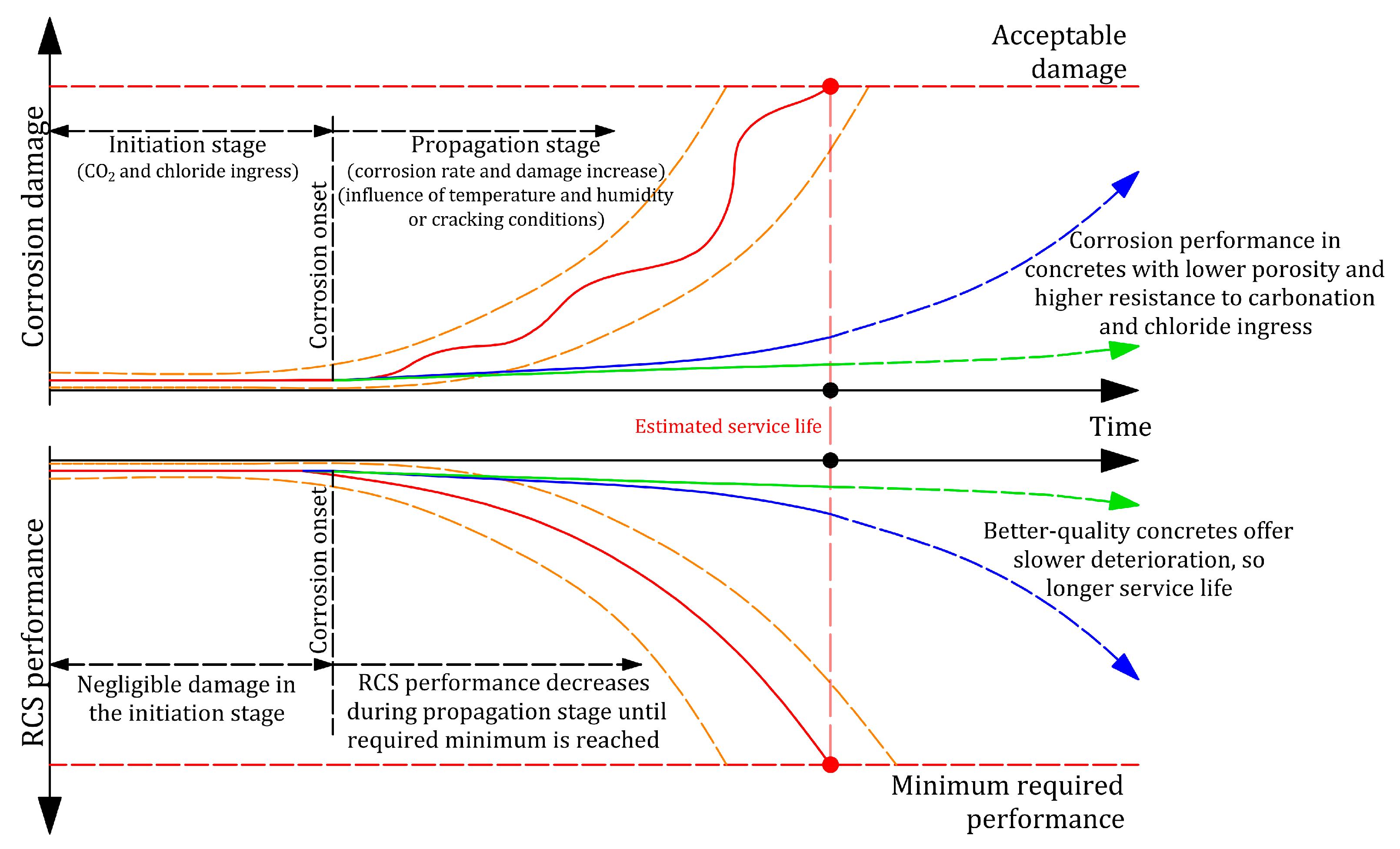
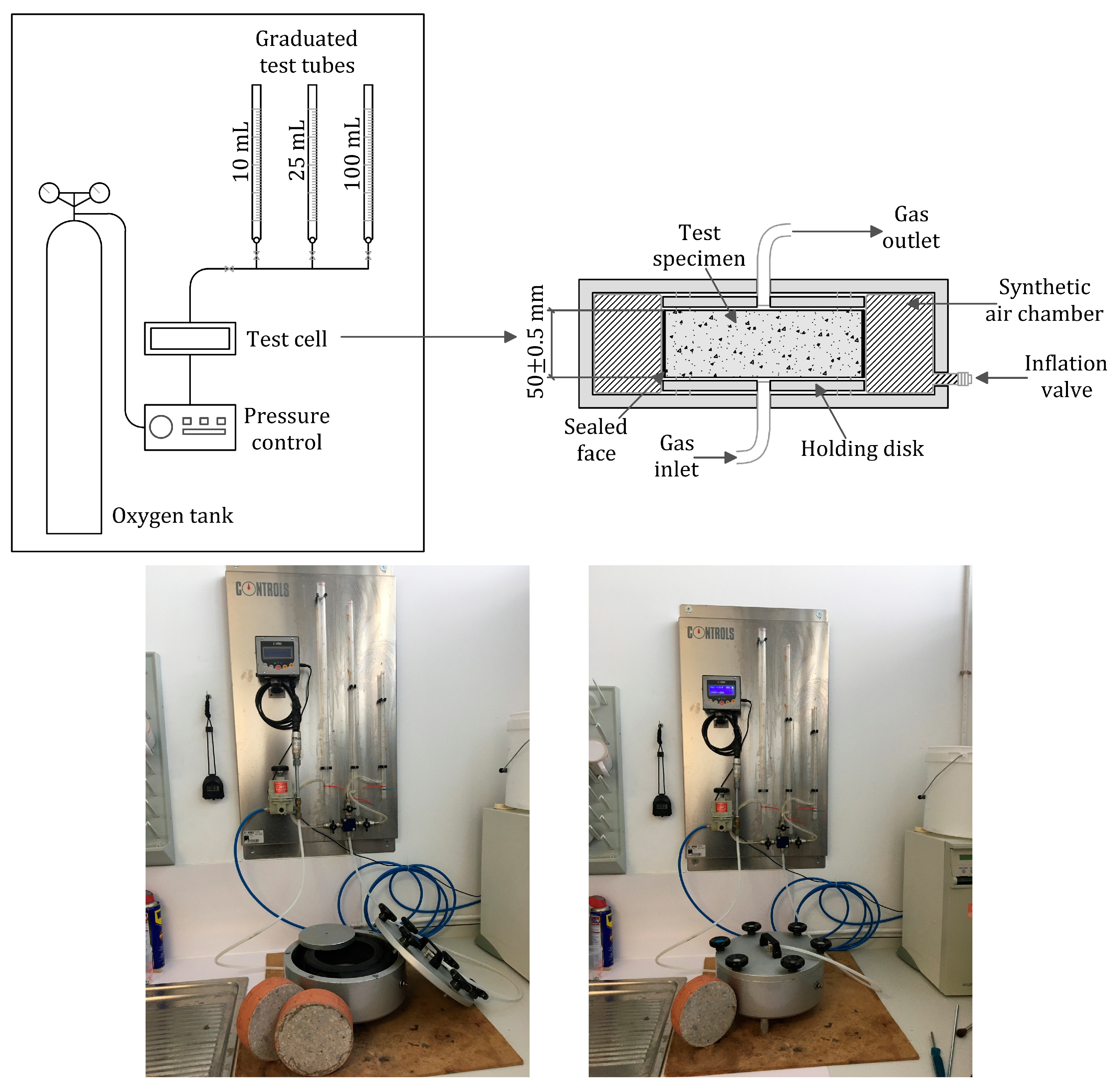








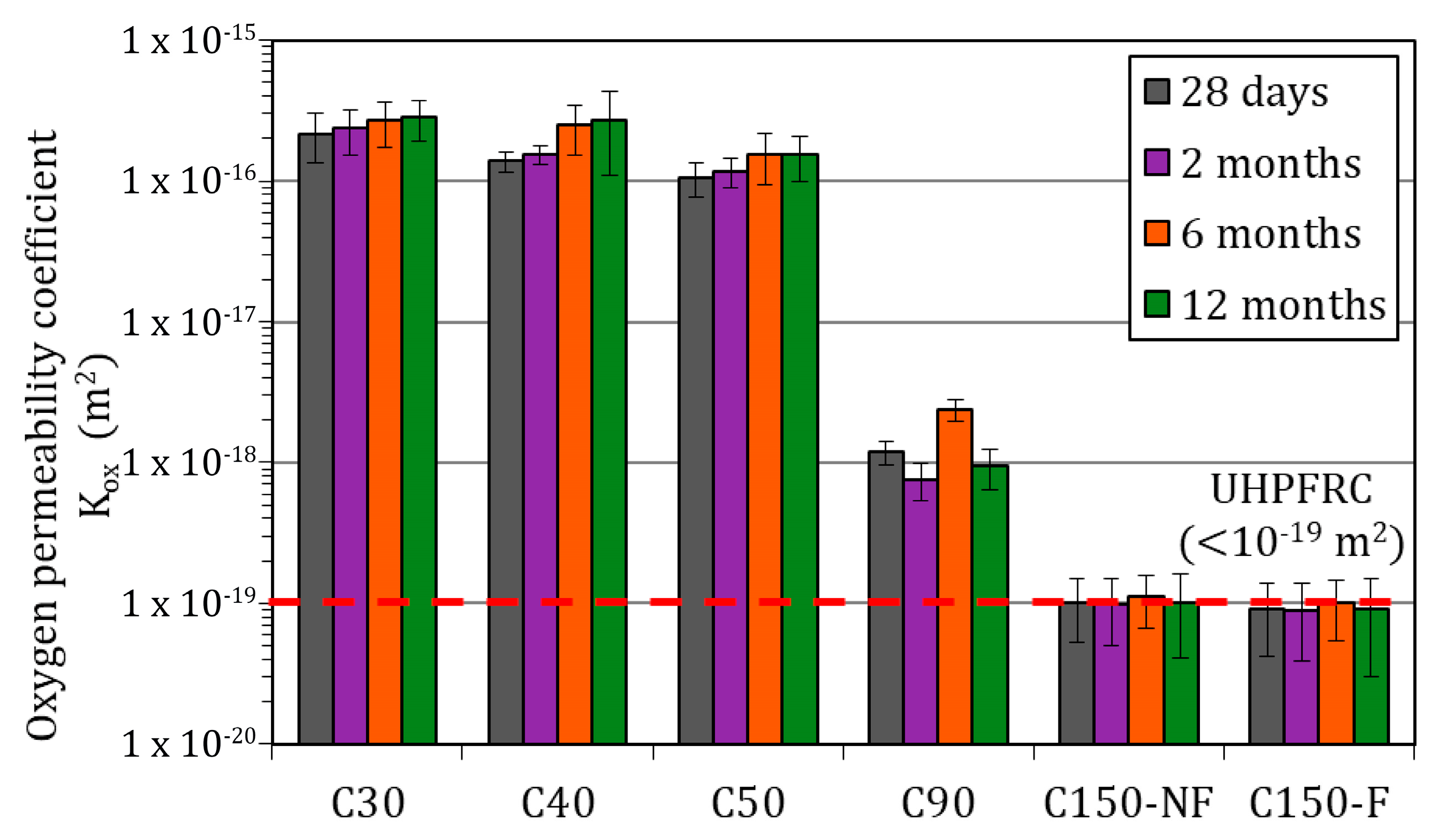

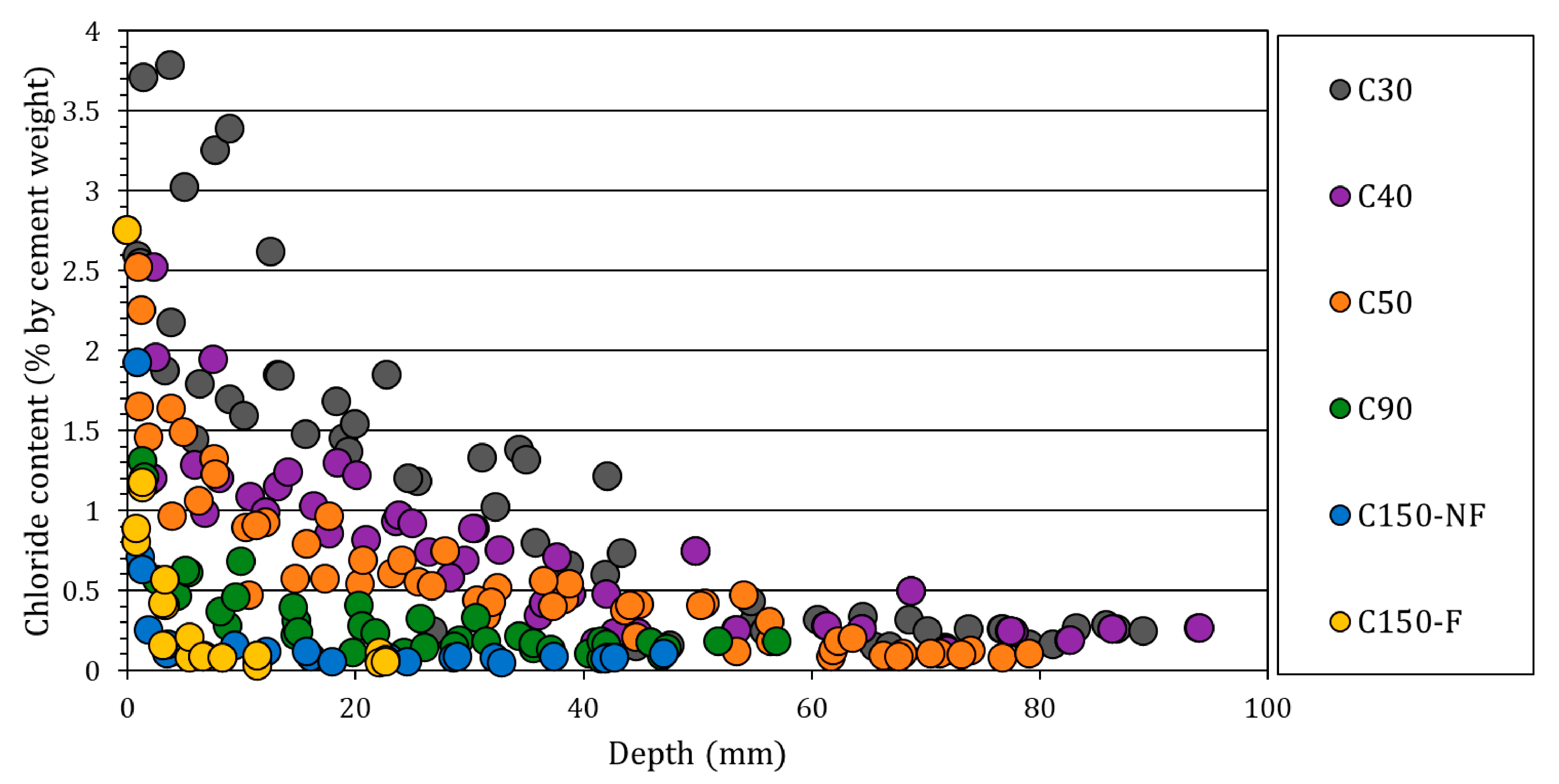



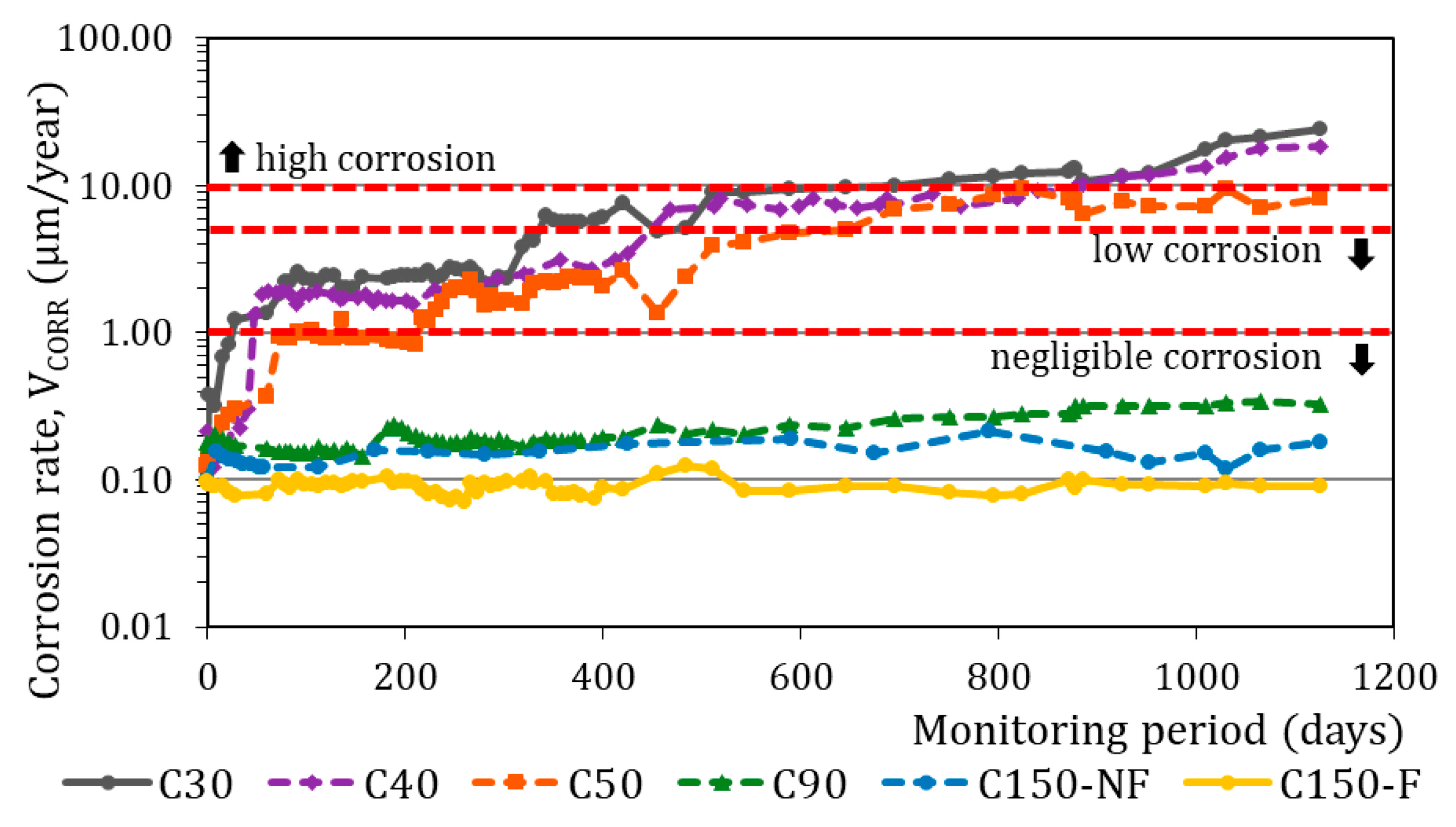


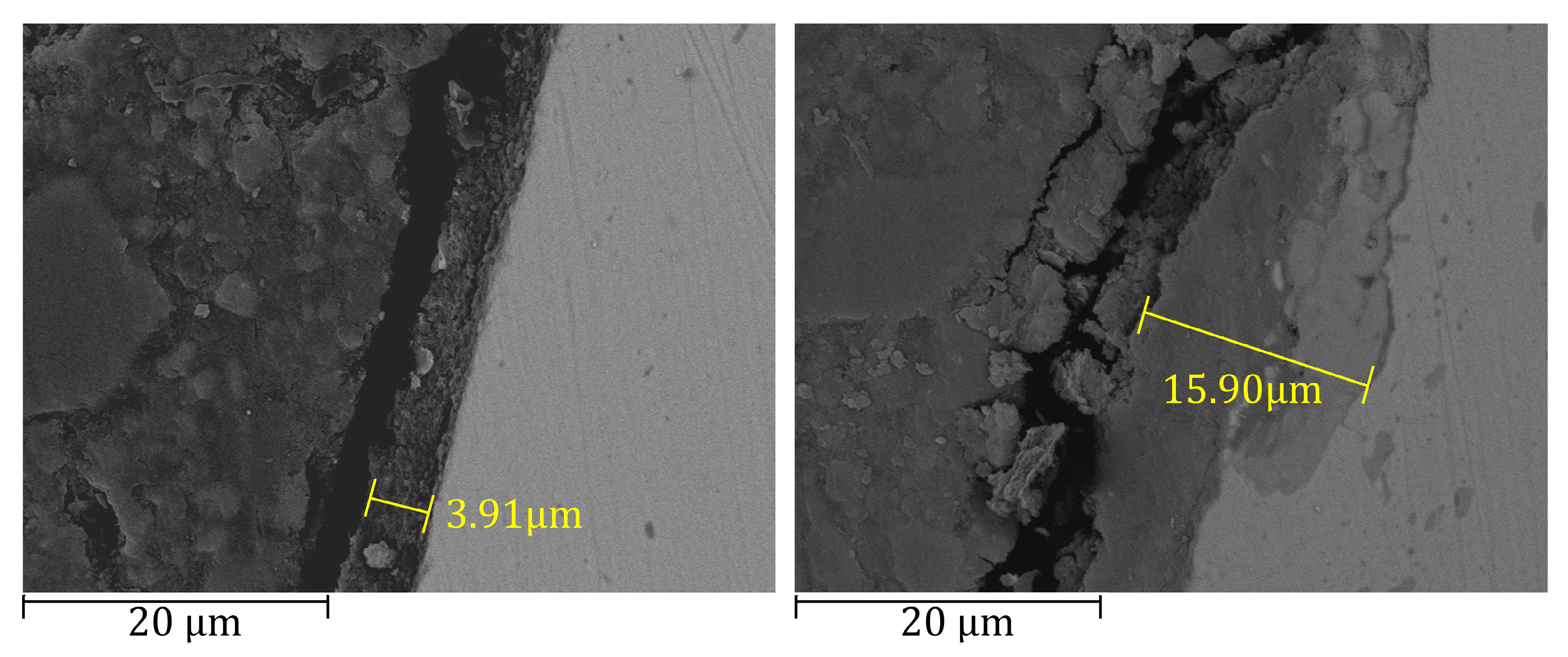
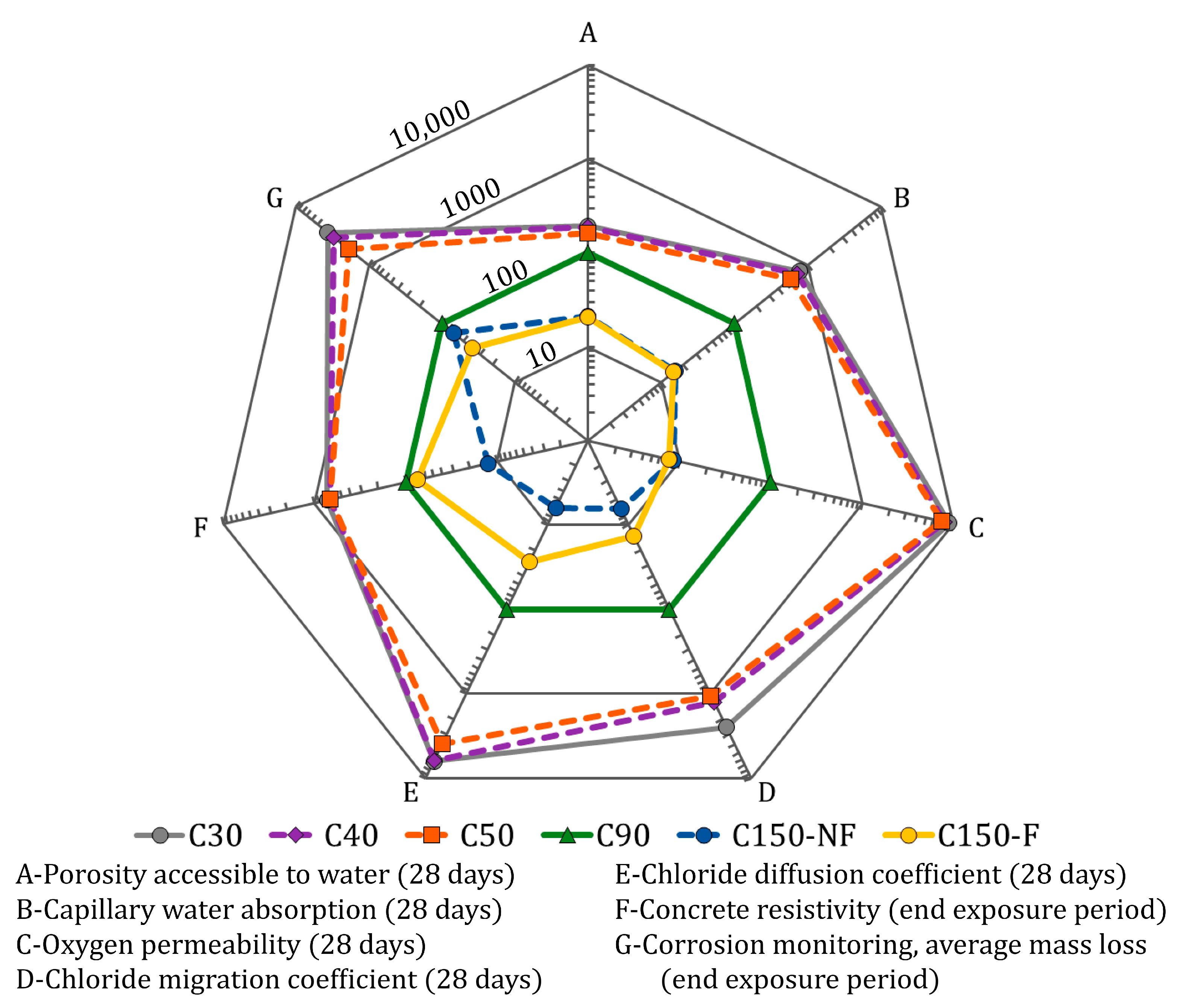
| C30 | C40 | C50 | C90 | C150-NF | C150-F | |
|---|---|---|---|---|---|---|
| CEM II 32.5, B-L | 307 | - | - | - | - | - |
| CEM I 42.5, R-SR | - | 292 | 450 | 500 | 800 | 800 |
| Water | 184 | 190 | 225 | 178 | 160 | 160 |
| Superplasticiser | 1.85 | 2.80 | 1.37 | 3.50 | 30 | 30 |
| Silica fume | - | - | - | 55 | 175 | 175 |
| Silica flour | - | - | - | - | 225 | 225 |
| Limestone sand (0/0.5) | - | - | - | - | 302 | 302 |
| Limestone sand (0.6/1.2) | - | - | - | - | 565 | 565 |
| Limestone sand (0/4) | 1438 | 1256 | 880 | 914 | - | - |
| Limestone gravel (4/7) | - | - | 880 | 779 | - | - |
| Limestone gravel (4/12) | 491 | 707 | - | - | - | - |
| Steel fibres (Ø 2 × 13 mm) | - | - | - | - | - | 175 |
| w/b 1 ratio | 0.60 | 0.65 | 0.50 | 0.32 | 0.16 | 0.16 |
| (3 days) | 19.51 | 23.49 | 26.77 | 63.92 | 98.29 | 81.02 |
| (7 days) | 25.40 | 32.20 | 35.31 | 70.15 | 118.64 | 112.45 |
| (28 days) | 30.67 | 39.47 | 51.75 | 88.86 | 129.76 | 135.43 |
| (2 months) | 31.88 | 41.23 | 48.14 | 94.45 | 161.05 | 145.72 |
| (1 year) | 30.11 | 38.78 | 47.93 | 85.67 | 151.96 | 148.23 |
Disclaimer/Publisher’s Note: The statements, opinions and data contained in all publications are solely those of the individual author(s) and contributor(s) and not of MDPI and/or the editor(s). MDPI and/or the editor(s) disclaim responsibility for any injury to people or property resulting from any ideas, methods, instructions or products referred to in the content. |
© 2023 by the authors. Licensee MDPI, Basel, Switzerland. This article is an open access article distributed under the terms and conditions of the Creative Commons Attribution (CC BY) license (https://creativecommons.org/licenses/by/4.0/).
Share and Cite
Lliso-Ferrando, J.R.; Gandía-Romero, J.M.; Soto, J.; Valcuende, M. OC, HPC, UHPC and UHPFRC Corrosion Performance in the Marine Environment. Buildings 2023, 13, 2439. https://doi.org/10.3390/buildings13102439
Lliso-Ferrando JR, Gandía-Romero JM, Soto J, Valcuende M. OC, HPC, UHPC and UHPFRC Corrosion Performance in the Marine Environment. Buildings. 2023; 13(10):2439. https://doi.org/10.3390/buildings13102439
Chicago/Turabian StyleLliso-Ferrando, Josep Ramon, José Manuel Gandía-Romero, Juan Soto, and Manuel Valcuende. 2023. "OC, HPC, UHPC and UHPFRC Corrosion Performance in the Marine Environment" Buildings 13, no. 10: 2439. https://doi.org/10.3390/buildings13102439
APA StyleLliso-Ferrando, J. R., Gandía-Romero, J. M., Soto, J., & Valcuende, M. (2023). OC, HPC, UHPC and UHPFRC Corrosion Performance in the Marine Environment. Buildings, 13(10), 2439. https://doi.org/10.3390/buildings13102439








